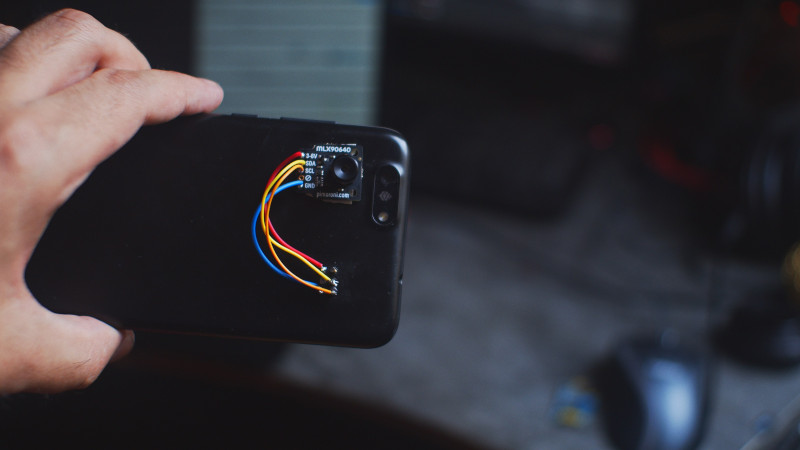When you buy a mass-market mobile phone, you’re making the decision to trust a long list of companies with your private data. While it’s difficult for any one consumer to fully audit even a single piece of consumer technology, there have been efforts to solve this problem to a degree. The Pinephone is one such example, with a focus on openness and allowing users to have full control over the hardware. [Martijn Braam] is a proud owner of such a device, and took advantage of this attitude to add a thermal imager to the handset.
The build is not a difficult one, thanks to the expansion-friendly nature of the Pinephone hardware. The rear of the phone sports six pogo pins carrying an I2C bus as well as power. [Martin] started by modifying the back cover of the phone with contacts to interface with the pogo pins. With this done, the MLX90640 thermal imager was attached to the case with double-sided tape and wired up to the interface.
While the 32×24 output from the sensor isn’t going to help you build cutting edge heat-seeking missiles, it’s an affordable sensor with good performance for low-end thermal imaging tasks. We’ve featured teardowns of thermal imaging hardware before, too.
















Good work getting started! I’d try my hand at a proper 3D printed backplate if it was more functional.
Hopefully someone with more time than me runs with this and makes a nice compositor for the v4l2 interface and an onboard camera. Unless that’s a built in (in v4l2) and the author just didn’t mention it.
It’s not built-in, there’s a v4l2 driver for this thermal camera in linux currently, but it isn’t really in an usable state. The sensor returns 26 rows of pixels instead of 24, the first two rows is extra data like the temperature and gain of the sensor that’s needed to calculate the correct values for the rest of the pixels, since this is not image data these two rows aren’t included in the v4l2 driver, making it pretty much useless.
Also since I just used tape to attach the camera it will not stay aligned enough to do that properly. I’m trying to get correct thermal data from it first.
Ah, that’s irritating. I’ll go check out the cost on those thermals and keep an eye on the project. Thanks for posting it up!
I wonder if you can use something like image stacking, or another super-resolution technique to increase the resolution of images obtained with sensor?
Of course you can, but good image stacking typically requires a substantial number of overlapping frames, meaning that your display screen frame rate will drop commensurately. Then there’s computation time…
Well it’s a sub kilopixel sensor, so unless you do it in an interpreted language or something stupid, the computation time should be minimal on modern hardware.
Very cool! How many FPS can be expected once the software is mature ?
The sensor docs say 8FPS is reasonable for “raspberry pi platforms”, but it looks like the sensor can go up to 64FPS.
This sensor is interlaced though, so that halves the refresh rate if you’re interested in complete frames only.
“Laughs in used CAT S60/S61”
The real achievement here is FINDING MLX90640 sensors in stock anywhere! Does anyone have a source for these? I assume that every wannabe maker has bought them all so they can build covid thermal sensors :-)
Hah I bought this one last year because thermal sensors are neat. has been in my parts bin for a while.
They sure are neat. And this sensor has j-u-s-t enough resolution to make a useful thermal imaging camera for the workshop, for a fraction of the price of a “real” FLIR….